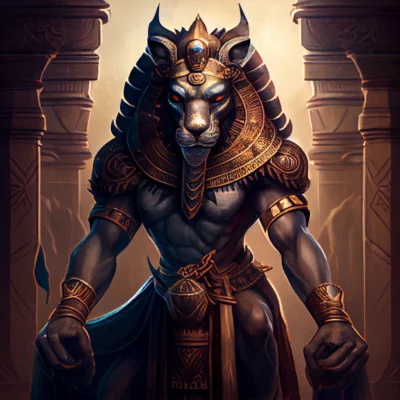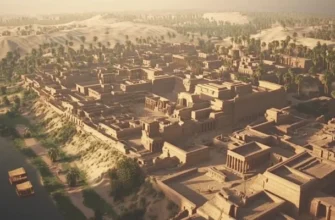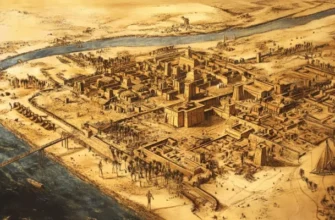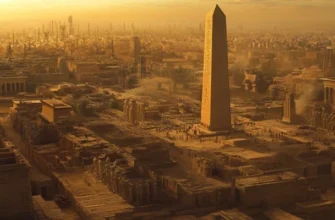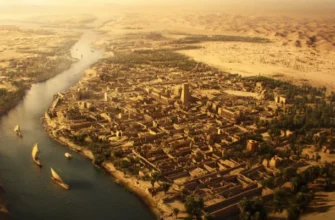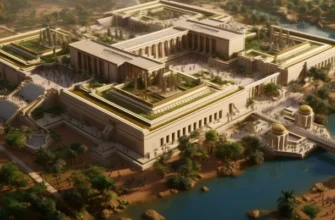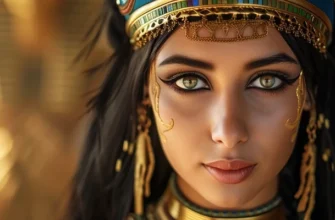The Egyptian god Nefertum is the god of beauty, cosmetics, and perfumes, who symbolized renewal and rebirth. His name literally means “well-formed”, indicating his role in creating beauty and harmony in all living things. Nefertum was depicted with a lotus flower on his head, symbolizing his connection to nature. He was an ancient Egyptian god who played an important role in the religion and culture of the ancient Egyptian civilization.
- The importance of Nefertum in Egyptian mythology
- Nefertum mythology: origin and symbolism
- The story of the origin of Nefertum and the story of his mythological significance
- Symbolism of Nefertum: his images and attributes
- The cult of Nefertum: religious significance and rituals
- The role of Nefertum in Egyptian religion and the rituals associated with this god
- Temples and shrines of Nefertum
- Representation of Nefertum in art: depictions and interpretation
- The story of the depiction of Nefertum in various editions of Egyptian art
- Interpretation of images and their meaning in the context of Egyptian culture
- Conclusion
The importance of Nefertum in Egyptian mythology
Nefertum was one of the most important gods in Egyptian mythology. He symbolized beauty, art, and harmony in nature and human life. Many artifacts that have survived from ancient Egypt contain images of Nefertum, which testifies to his importance in the religion and culture of the time. He was a source of inspiration for many artists and craftsmen who depicted him on various objects such as amulets, figurines, wall paintings, and patterns on clothing. To this day, Nefertum is one of the most popular gods of Egyptian mythology, leaving his mark on culture and art.
Nefertum mythology: origin and symbolism
Nefertum in Egyptian mythology was the son of the god Seker and the goddess Hathor. He symbolized beauty, art, and harmony in nature and human life. He was usually depicted with a lotus flower on his head, which symbolized his connection to nature and renewal. He was also often depicted with a bull’s head, which reflected his military strength and courage.
Nefertum was associated with rebirth and eternity. He played an important role in burial rituals, where he ensured that the soul of the deceased could come to life again and start a new life. Nefertum was also a deity of the healing arts, often associated with magic and spiritual healing.
All of these aspects of Nefertum’s symbolism made him one of the most influential and important gods in Egyptian mythology.
The story of the origin of Nefertum and the story of his mythological significance
The Egyptian god Nefertum was considered one of the most ancient gods of Egyptian mythology. His origin was associated with the legend of the creation of the world. According to this legend, Nefertum was born together with his parents, the god Seker and the goddess Hathor.
In mythology, Nefertum played an important role in burial and rebirth rituals, where he symbolized eternity and the renewal of life. For example, he was often depicted on caskets for mummified bodies, where his image served as magical protection for the deceased.
Nefertum was also associated with the art of medicine and magic, which made him very popular among the people. His name meant “Beauty Comes,” reflecting his role in creating and renewing beauty in nature and human life.
All of these aspects of Nefertum’s mythology made him an important god in Egyptian religion and culture, which persisted for many centuries and leaves its mark on Egyptian culture and art to this day.
Symbolism of Nefertum: his images and attributes
The image of Nefertum in Egyptian mythology often included his head, which looked like a lion’s head or a lion with human features, with a bunch of long ears. He could also be depicted as a man with a lion’s tail.
One of the main attributes of Nefertum was the lotus flower he carried in his hand. This symbolized his role in the rebirth and renewal of life, as well as his connection to the goddess Isis, who was also often depicted with a lotus.
In addition, Nefertum was sometimes depicted with a casket for mummified bodies, reflecting his role in burial and rebirth rituals. He could also wear a crown of five leaves, symbolizing the five elements of nature.
All of these symbols and attributes of Nefertum reflected his important role in reviving life and caring for the health and beauty of people, making him one of the most revered gods in Egyptian mythology.
The cult of Nefertum: religious significance and rituals
The cult of Nefertum was of great religious importance to the Egyptians, especially during the New Kingdom. He was often mentioned in the texts of funerary rites, where he acted as a protector of the dead and performed rituals for the revival of their souls in the afterlife.
Nefertum was also associated with the maintenance of health and beauty, and people turned to him for help in healing and beauty. According to legend, prescriptions for health care products were kept in the temple of Nefertum to help treat skin and eye diseases.
The rituals associated with the cult of Nefertum included offering prayers and sacrifices in his honor, as well as the manufacture and use of various amulets that were supposed to protect against disease and ensure longevity.
In addition, festivals were organized in the temples of Nefertum, during which various religious rituals and entertainments were held. For example, during one of these festivals, a ceremony was held in the temple of Nefertum, during which a clay figure of Nefertum was raised to the top of the roof, symbolizing his rebirth and eternal life.
All of these rites and rituals testify to the great importance of the cult of Nefertum in Egyptian religion and its influence on the life and culture of this ancient civilization.
The role of Nefertum in Egyptian religion and the rituals associated with this god
Nefertum played an important role in Egyptian religion as a god of beauty, healing, and rebirth. His cult was associated with maintaining health and beauty, as well as with the rebirth of the dead in the afterlife.
There were various rituals associated with the cult of Nefertum, including offering prayers and sacrifices in his honor, making and using amulets to protect against disease and ensure longevity, and festivals during which various religious rituals and amusements were held.
One of the most famous rituals was the ritual of the “rebirth of Nefertum,” during which a clay figure of Nefertum was raised to the top of the roof, symbolizing his rebirth and eternal life. In addition, Nefertum was used in funerary rituals, where he protected the dead and helped them in the rebirth of their souls in the afterlife.
All of these rites and rituals testify to the great importance of the cult of Nefertum in Egyptian religion and its influence on the life and culture of this ancient civilization.
Temples and shrines of Nefertum
Temples and shrines of Nefertum were spread throughout Ancient Egypt. The most famous of them were located in Memphis and Heliopolis.
In Memphis, there was a temple of Nefertum, consisting of a shrine and a chapel dedicated to his wife, the goddess Sekhmet. In the temple were images of Nefertum, Sekhmet, and their sons, the gods Maat and Herisheph.
In addition, in many other cities of Egypt there were shrines dedicated to Nefertum and his family.
The temples and shrines held religious rites and ceremonies related to the cult of Nefertum, and their walls were decorated with hieroglyphs and images that told the mythology and symbolism of this god. They were an important part of the cultural heritage of Ancient Egypt.
Representation of Nefertum in art: depictions and interpretation
Nefertum was often depicted in Egyptian art with a bluestem or lotus flower on his head, symbolizing his healing properties. He was also often depicted with a weapon, indicating his military abilities.
In art, Nefertum sometimes appears with his wife, the goddess Sekhmet, or with his children, the gods Maat and Herishefa. This indicated his family ties and his role as a father and husband.
Nefertum was also depicted in hieroglyphics and paintings with other gods, such as Ra, Osiris, and Isis. This indicated his role in Egyptian mythology as the god of creation and life.
His depictions in art and hieroglyphics were an important part of the cultural heritage of Ancient Egypt, helping to preserve and transmit knowledge of its mythology and symbolism to future generations.
The story of the depiction of Nefertum in various editions of Egyptian art
In medieval art, he was depicted in bronze armor, with weapons, and often with the ear of a bull, which symbolized his military abilities. In the Greco-Roman period, Nefertum was depicted with feathers on his head, carved into a marble statue, and often appeared on coins.
In hieroglyphics and paintings on temple walls, Nefertum was often depicted together with other gods, such as Ra, Osiris, and Isis. His depictions in art and hieroglyphics were an important part of the cultural heritage of Ancient Egypt, helping to preserve and transmit knowledge of its mythology and symbolism to future generations.
Interpretation of images and their meaning in the context of Egyptian culture
Images of Nefertum in Egyptian art had a deep symbolic meaning. Many details in the image of the god reflected his functions and properties. For example, the lotus flower on his head symbolized his healing properties, and the feathers on his head, which appeared in the later period, may indicate his bird attributes, which indicates his belonging to the world of the bird gods.
His image often appeared together with other gods, indicating his role as a mediator between them. His attributes, such as weapons or armor, indicated his military abilities and his role in the struggle to defend Egypt from enemy forces.
Depictions of Nefertum were also important in a cultural context, as they were not only artistic creations, but also helped to preserve and transmit knowledge about the mythology and symbolism of the god to future generations. Such images could be found on the walls of temples, in cities, as well as on various religious sites, which testified to the great religious and cultural reverence of Nefertum for the Egyptian people.
Conclusion
The significance of the god Nefertum in Egyptian mythology and religion lies in his role as creator and deity of rebirth. His symbolism and images were widespread in Egyptian art and architecture. The cult of Nefertum included rituals that promoted rebirth and eternal life. The legacy of the god Nefertum was manifested in his influence on other aspects of Egyptian culture and art. He became one of the most important symbols of Egyptian mythology and religion, and his cult has survived to this day in the form of archaeological finds and historical documents.
To summarize, Nefertum, as the god of creation and rebirth, was of great importance in Egyptian mythology and religion. His symbolism, images, and cult rites were inextricably linked to the rituals of rebirth and eternal life. It also had an important place in Egyptian art and architecture.
